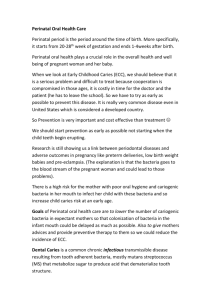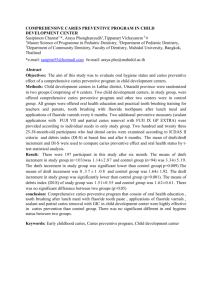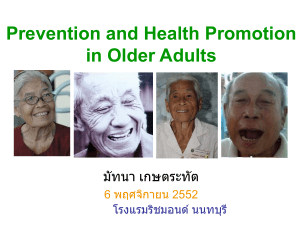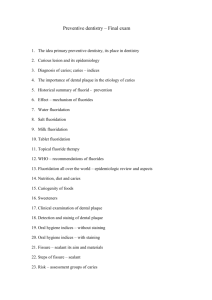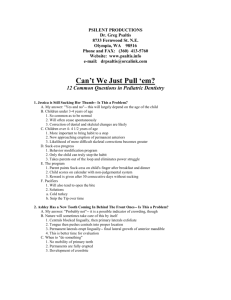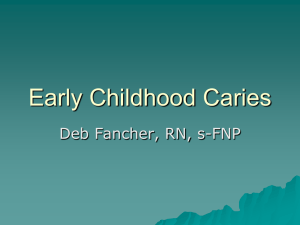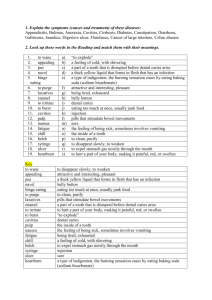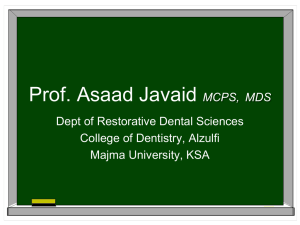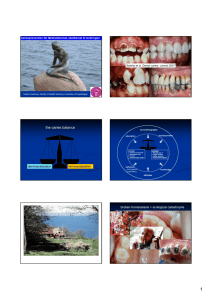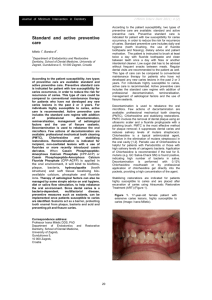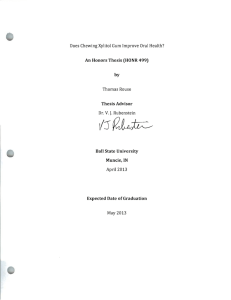Preventive,Sheet9 - Clinical Jude
advertisement
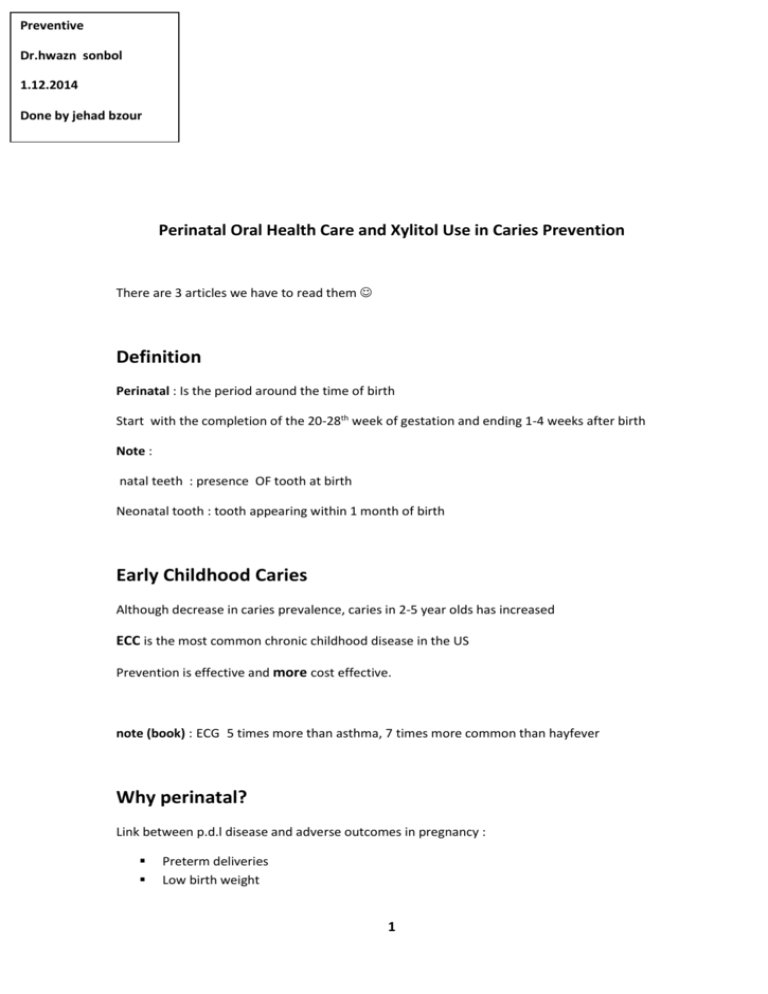
Preventive Dr.hwazn sonbol 1.12.2014 Done by jehad bzour Perinatal Oral Health Care and Xylitol Use in Caries Prevention There are 3 articles we have to read them Definition Perinatal : Is the period around the time of birth Start with the completion of the 20-28th week of gestation and ending 1-4 weeks after birth Note : natal teeth : presence OF tooth at birth Neonatal tooth : tooth appearing within 1 month of birth Early Childhood Caries Although decrease in caries prevalence, caries in 2-5 year olds has increased ECC is the most common chronic childhood disease in the US Prevention is effective and more cost effective. note (book) : ECG 5 times more than asthma, 7 times more common than hayfever Why perinatal? Link between p.d.l disease and adverse outcomes in pregnancy : Preterm deliveries Low birth weight 1 High levels of cariogenic bacteria in mother is at higher risk of transferring cariogenic bacteria to their child Goal of perinatal oral health care To lower the number of cariogenic bacteria in expectant mother’s mouth so that MS colonization of the infant can be delayed as long as possible. Delivery of educational information and preventive therapies to parents can reduce the incidence of ECC and improve the oral health of their children. Dental caries: Common chronic infectious transmissible disease resulting from tooth-adherent specific bacteria, (MS), that metabolize sugar to produce acid which over time demineralizes the tooth structure Parents must be aware of the fact that caries is infectious MS colonization Bacteria colonization of an infant may occur from birth Significant colonization occurs after dental eruption as teeth provide non-shedding tooth surfaces for adherence Other surfaces may harbor MS (tongue) Vertical Transmission Genotypes of MS in infants appear identical to those in mothers (24 to 100%) Related to several factors : Magnitude of the inoculums Frequency of inoculation Maternal salivary MS levels Mother’s oral hygiene Periodontal disease Snack frequency Socioeconomic status 2 Horizontal transmission Transmission between members of a group such as siblings Children with severe ECC – non-maternal MS genotypes were identified in the majority (74%) of children Recommendations for Perinatal Health Care 1.Caries risk assessment 2.Anticipatory guidance 3.Preventive strategies 4.Therapeutic interventions Now we will talk about them in details ,,,,, Goal of Caries Risk Assessment (To know if the patients have relative risk factors for caries). *to prevent the disease by identifying and minimizing causative factors : Microbial burden Dietary habits Plaque accumulation * to optimize protective factors that prevent the disease : Fluoride Oral hygiene Fissure sealants 3 Caries risk assessment Biological : Mother/caregiver Low socioeconomic status Snacks Protective factors: Fluoride Regular dental care Clinical findings: White spot lesions Cavities or fillings Plaque Anticipatory guidance For mother or other caregivers Modification of mother’s oral hygiene and diet Use topical fluorides/chlorhexidine Note Use of fluoride and chlorhexidine and reduce MS levels significanlty in the mother and so decrease the infants leves and caries rate Preventive Strategies: Recommendations 1.Oral health education 2.Oral hygiene 3.Diet 4.Fluoride 5.Professional oral health care 4 Oral health education *Self-care *Future child care *Early intervention and counseling from all health care providers (physicians, dentists, nurses) Oral hygiene Tooth brushing with fluoridated toothpaste and flossing to reduce bacteria plaque levels. *Periodontal disease link to pregnancy outcomes Note(article) Periodontal infections which can be a reservoir for inflammatoryy mediators can pose a threat to the placenta and fetus with can increase the likelihood of preterm delivery. Mothers with severe periodontitits have high levels of prostaglandins in the gingival crevicular fluid and blood which may be associated with uterine contractions leading to preterm delvieries. Morning sickness Frequent vomiting : rinse with water with tspn of baking soda can help reduce erosion Reduce caries risk : F toothpaste, chewing sugarless and xylitol-containing gum, eating small amount of nutritious food throughout the day Diet Healthy diet Food cravings may lead to consumption of foods that increase mother’s caries risk Education regarding limiting direct transmission (sharing utensils) Fluoride Toothpaste Rinse 5 Professional Health Care Removal of active caries and restoration so helps suppress maternal MS reservoirs to minimize the transfer of MS reservoirs to infant Dental treatment can be accomplished safely at any time in pregnancy Second trimester is the safest time for treatment Xylitol chewing gum Chewing (at least 2 or 3 times a day) by mother has a significant impact on motherchild transmission of MS and decreasing the child’s caries rate Naturally occurring 5-carbon sugar Has properties that reduce levels of MS in plaque and saliva Disrupts the energy production process in MS so cell death Xylitol users : MS strains with lower adherence and decreased virulence (less acid production) Evidence 3 week or more consumption by children short and long-term reduction in salivary and plaque MS levels Some studies did not show long-term reduction Other studies have shown reduction of MS for up to 5 years after cessation of xylitol AAPD Recommendation Moderate-high caries-risk patients Reassess caries risk every 6 months 6 Dosage : Total Daily dosages of 3 to 8 grams for adequate clinical effect Delivery methods – gum, syrup, lozenges Dosing frequency – minimum of 2 times/day Gum AAPD does not recommend use of xylitol chewing gum mints or hard candy by children less than 4 years of age due to risk of choking Syrup 3-8 grams/day in divided doses Reduced caries by 50-70% in children 15 to 25 months of age Other Energy bars and food Oral hygiene products (rinses, gels, floss, wipes) Toothpaste – 5% formulations have shown reduced MS levels – still not available Side effects : Safe if in therapeutic doses At high doses – osmotic diarrhea and gas Subside once xylitol consumption is stopped To minimize gas and diarrhea, xylitol should be introduced slowly, over a week to acclimate the body to the polyol Conclusion Xylitol syrup < 4 yrs old > 4 yrs old 3-8 grams/day 3-8 grams/day Age appropriate products (gum/ lozenges/ snack foods such as gummy bears) 7
